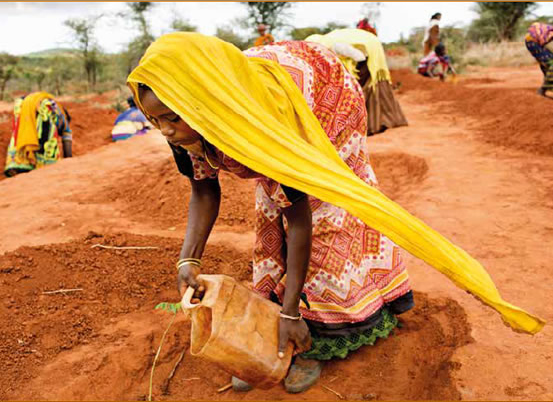
training project in Ethiopia. Photo: Mikkel Ostergaard/Panos/IDS Bulletin
A call for the humanitarian aid- and climate change sectors to work together to support long-term adaptation to climate change.
Written by Jayne Lambrou, Faculty of Landscape and Society, NMBU.
In the latest edition of the IDS Bulletin, the Noragric-led project ‘Courting Catastrophe? Humanitarian Policy and Practice in a Changing Climate‘ presents its findings in a collection of articles that examine links between humanitarian crises, the responses that follow and adaption to climate change.
In this project, various types of humanitarian interventions were examined in case studies spanning several countries in which the institutional and policy contexts of the interventions were also assessed. Here, we look briefly at some of these case studies, and present a taster of the project’s findings in a video featuring interviews with some of the project partners, including project leader Siri Eriksen.
Bangladesh
The population of Bangladesh is largely concentrated around the low-lying coastline; Maxmillan Martin from the University of Sussex explains how this has contributed to the devastating effect of the increasingly frequent and intense cyclones and the resulting sea surges that hit the country. People, cattle, crops and homes are wiped out. Disaster risk reduction measures in this country require better ways of predicting such events, as well as better-planned responses to both save lives and to save livelihoods, says Martin.
Ethiopia
In the Afar Region in eastern Ethiopia, a major challenge has been in the distribution of food aid, with too few distribution centres placed over a large area. Fetien Abey from Mekelle University describes how, with men from this region often migrating to find work, women often miss the opportunity of receiving food aid as they are not able to leave children, elders, livestock, crops and households unattended in order to travel the long distances required. Whilst this has improved in recent years with an increase in the number of distribution centres, there is still a problem in getting the food aid where it is needed, says Abey.
Kenya
Lars Otto Næss from the Institute of Development Studies observes that, whilst the humanitarian sector in Kenya (as in Ethiopia) has come a long way in integrating resilience and long-term perspectives into its work, it continues to face major challenges. He gives three examples:
- Institutional fragmentation. There is a need to facilitate discussions to integrate the large, fragmented network of actors and institutions, and for government coordination.
- ‘Projectisation’ of resilience/adaptation work, where targeted projects only look at specific elements without regard to the wider issues. Often only the symptoms of vulnerability are addressed rather than the causes.
- Financing of humanitarian assistance may lack flexibility; financing recovery from disaster is perhaps less complex than financing preparedness measures.
Referring to an intervention in north west Kenya which provided an improved variety of cassava (more drought-tolerant, faster maturing, more productive and more tolerant to diseases than standard cassava varieties), Noragric’s Andrei Marin states the importance of the consideration of social backgrounds in such interventions. Who owns the land and who decides on the access to land at the sites of the interventions? As this crop requires quite a lot of land to grow sufficiently, these are important considerations, says Marin.
Pakistan
Ingrid Nyborg (Noragric) explains that, in recent years, there has been a lot of activity between humanitarian/development organisations and the government in Pakistan, in an attempt to set up systems that better respond to humanitarian emergencies and also look for longer-term solutions. The findings of this case study reveal that, whilst this activity has been considerable at the national level, there has, until recently, been very little activity at the district levels – yet it is the latter that primarily respond to crises. The national disaster management authority in Pakistan is now heavily engaged in competence-building at the district as well as at the provincial levels, to address social- as well as hazard vulnerability.
Malawi
Ruth Haug (Noragric) recounts how Malawi, a country with a history of food insecurity, was more or less able to feed itself over a 10-year period and even export maize to Kenya and Zimbabwe after the introduction of a ‘preparedness’ measure in the form of a social protection programme. This programme included actions such as providing the largely subsistence agriculture-dependent population with subsidized fertilizer and seed. However, whilst Malawi was able to build resilience during this period, the serious floods and El Niño-induced droughts that followed in 2015/16 were too much and the country was again thrown into famine and humanitarian crisis.
Nepal
Sigrid Nagoda (then based at Noragric) spent 3 years in Humla in northwest Nepal where she studied policy processes, humanitarian interventions and power relations with a focus on food security and climate change adaptation. She reveals that one of the challenges to humanitarian assistance that she identified in this region was how to reach the poorest. Nagoda observed that the ‘community user groups’ provided by humanitarian actors were dominated by men from ‘higher’ castes, which limited the decision-making processes. Project leader, Siri Eriksen (Noragric) recounts how, in this case study, “food aid and accompanying development programmes thus tended to legitimise unequal power relations at the village level and dependence of the food insecure households on the wealthier households”.
Hear about these case studies and more in the video above.
Read the latest issue of the IDS Bulletin. All articles are open access.
 Jayne Lambrou is a Senior Advisor in communication and events at the Faculty of Landscape and Society at the Norwegian University of Life Sciences.
Jayne Lambrou is a Senior Advisor in communication and events at the Faculty of Landscape and Society at the Norwegian University of Life Sciences.


